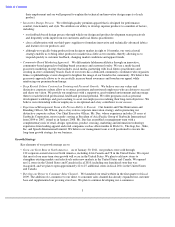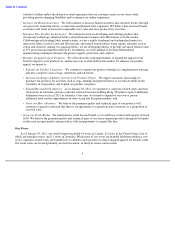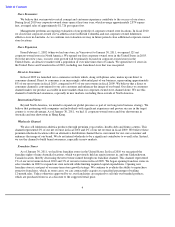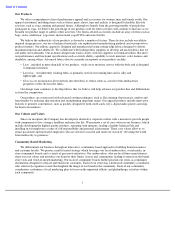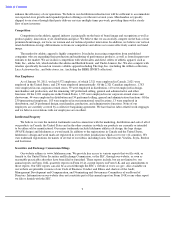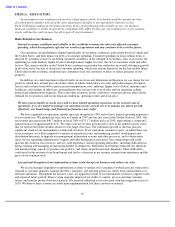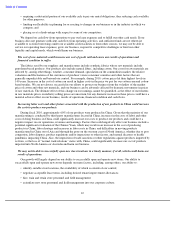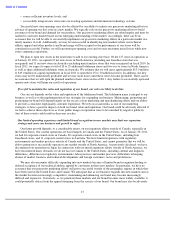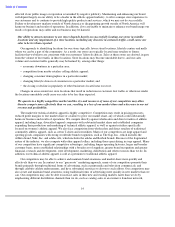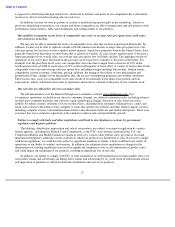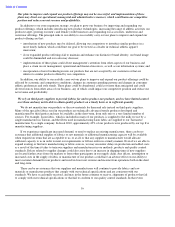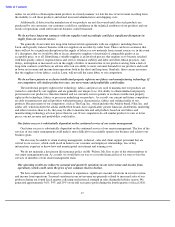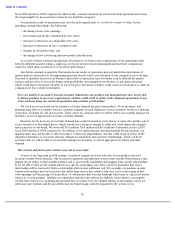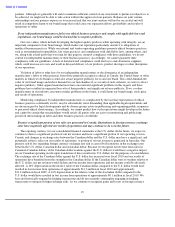Lululemon 2010 Annual Report Download - page 15
Download and view the complete annual report
Please find page 15 of the 2010 Lululemon annual report below. You can navigate through the pages in the report by either clicking on the pages listed below, or by using the keyword search tool below to find specific information within the annual report.
Table of Contents
An investment in our common stock involves a high degree of risk. You should carefully consider the risks
described below together with all of the other information included or incorporated by reference in this
Form 10
-K before making an investment decision. If any of the following risks actually occurs, our business,
financial condition or results of operations could materially suffer. In that case, the trading price of our common
stock could decline, and you may lose all or part of your investment.
Risks Related to Our Business
General economic conditions and volatility in the worldwide economy has adversely affected consumer
spending, which has negatively affected our results of operations and may continue to do so in the future.
Our operations and performance depend significantly on economic conditions, particularly those in Canada and
the United States, and their impact on levels of consumer spending. Consumer spending on non-essential items is
affected by a number of factors, including consumer confidence in the strength of economies, fears of recession, the
tightening of credit markets, higher levels of unemployment, higher tax rates, the cost of consumer credit and other
factors. The current volatility in the United States economy in particular has resulted in an overall slowing in growth
in the retail sector because of decreased consumer spending, which may remain depressed for the foreseeable future.
These unfavorable economic conditions may continue to lead our customers to delay or reduce purchase of our
products.
In addition, we could experience reduced traffic in our stores and limitations on the prices we can charge for our
products, which may include price discounts, either of which could reduce our sales and profit margins. Economic
factors such as those listed above and increased transportation costs, inflation, higher costs of labor, insurance and
healthcare, and changes in other laws and regulations may increase our cost of sales and our operating, selling,
general and administrative expenses. These and other economic factors could have a material adverse affect on the
demand for our products and on our financial conditions, operating results and stock price.
We have grown rapidly in recent years and we have limited operating experience at our current scale of
operations; if we are unable to manage our operations at our current size or to manage any future growth
effectively, our brand image and financial performance may suffer.
We have expanded our operations rapidly since our inception in 1998 and we have limited operating experience
at our current size. We opened our first store in Canada in 1999 and our first store in the United States in 2003. Our
net revenue increased from $40.7 million in fiscal 2004 to $711.7 million in fiscal 2010, representing a compound
annual increase of approximately 61%. We expect our net revenue growth rate to slow as the number of new stores
that we open in the future declines relative to our larger store base. Our substantial growth to date has placed a
significant strain on our management systems and resources. If our operations continue to grow, of which there can
be no assurance, we will be required to continue to expand our sales and marketing, product development and
distribution functions, to upgrade our management information systems and other processes, and to obtain more
space for our expanding administrative support and other headquarters personnel. Our continued growth could
increase the strain on our resources, and we could experience serious operating difficulties, including difficulties in
hiring, training and managing an increasing number of employees, difficulties in obtaining sufficient raw materials
and manufacturing capacity to produce our products, and delays in production and shipments. These difficulties
could result in the erosion of our brand image and lead to a decrease in net revenue, income from operations and the
price of our common stock.
Any material disruption of our information systems could disrupt our business and reduce our sales.
We are increasingly dependent on information systems to operate our e-commerce
website, process transactions,
respond to customer inquiries, manage inventory, purchase, sell and ship goods on a timely basis and maintain cost-
efficient operations. Throughout the past few years, we upgraded certain of our information systems to support recent
and expected future growth. These system upgrades improved our ability to capture, process and ship customer
orders, and transfer product between channels. We incurred additional costs associated with these upgrades in fiscal
2010. We believe these systems are stable upon implementation, but there can be no assurance
10
ITEM 1A.
RISK FACTORS





